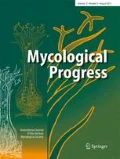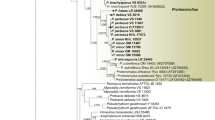Abstract
Three species currently addressed to Protohydnum (Auriculariales) are studied with morphological and DNA methods. The genus Protohydnum is retained for the type species only, P. cartilagineum, recently re-collected in Brazil. The European species, P. piceicola, is not congeneric with P. cartilagineum and, therefore, placed in its own genus, Hyalodon, gen. nov. Another Hyalodon species, H. antui, is described from East Asia. The third member of Protohydnum sensu lato, P. sclerodontium from South-East Asia, is transferred to Elmerina.





Similar content being viewed by others
References
Berbee ML, Wong EYY, Tsui CKM (2016) Phylogenetic evidence places the coralloid jelly fungus Tremellodendropsis tuberosa (Tremellodendropsidales) among early diverging Agaricomycetes. Mycol Prog 15:939–946
Bresadola G (1911) Fungi Borneensis. Ann Mycol 9:425–428
Bresadola G (1912) Polyporaceae Javanicae. Ann Mycol 10:492–508
Bresadola G (1913) Basidiomycetes Philippinenses. Series II. Hedwigia 53:44–80
Clements FE, Shear CL (1931) The genera of fungi. H.W. Wilson, NY 496 p
Hjortstam K, Spooner BM, Oldridge SG (1990) Some Aphyllophorales and heterobasidiomycetes from Sabah, Malaysia. Kew Bull 45:303–322
Jülich W (1980) Notulae et novitates Muluensis. Bot J Linn Soc 81:43–46
Landvik S (1996) Neolecta, a fruit-body producing genus of the basal ascomycetes, as shown by SSU and LSU rDNA sequences. Mycol Res 100:199–202
Lowy B (1971) Tremellaceae. Flora Neotropica 6:1–153
Lutzoni F, Kauff F, Cox CJ, McLaughlin D, Celio G, Dentinger B, Padamsee M, Hibbett D, James TY, Baloch E, Grube M, Reeb V, Hofstetter V, Schoch C, Arnold AE, Miadlikowska J, Spatafora J, Johnson D, Hambleton S, Crockett M, Shoemaker R, Sung GH, Lücking R, Lumbsch T, O’Donnell K, Binder M, Diederich P, Ertz D, Gueidan C, Hansen K, Harris RC, Hosaka K, Lim YW, Matheny B, Nishida H, Pfister D, Rogers J, Rossman A, Schmitt I, Sipman H, Stone J, Sugiyama J, Yahr R, Vilgalys R (2004) Assembling fungal tree of life: progress, classification, and evolution of subcellular traits. Am J Bot 91:1446–1480
Malysheva V, Spirin V (2017) Taxonomy and phylogeny of the Auriculariales (Agaricomycetes, Basidiomycota) with stereoid basidiocarps. Fungal Biol 121:689–715
Martin GW (1952) Revision of the North Central Tremellales State Univ Iowa Studies Nat Hist 19(3):1–122
Miettinen O, Spirin V, Niemelä T (2012) Notes on genus Aporpium (Auriculariales, Basidiomycota), with a new species from temperate Europe. Ann Bot Fenn 49:359–368
Möller A (1895) Protobasidiomyceten. Botanische Mittheilungen aus den Tropen 8:1–180
Parmasto E (1962) Species varietatesque nova fungorum. Tremellales et Aphyllophorales. Bot Mat Otdela Spor Rast 15:125–137
Parmasto E (1984) The genus Elmerina (Polyporaceae s.str.) Nova Hedwigia 39:101–116
Rambaut A, Suchard MA, Xie D, Drummond AJ (2014) Tracer v1.6. http://tree.bio.ed.ac.uk/software/tracer/ (accessed on 20.12.2017)
Reid DA (1992) The genus Elmerina (Tremellales), with accounts of two species from Queensland, Australia. Persoonia 14:465–474
Roberts P (1998) A revision of the genera Heterochaetella, Myxarium, Protodontia, and Stypella (Heterobasidiomycetes). Mycotaxon 69:209–248
Roberts P, Spooner BM (1998) Heterobasidiomycetes from Brunei Darussalam. Kew Bull 53:631–650
Ronquist F, Huelsenbeck JP (2003) MRBAYE S 3: Bayesian phylogenetic inference under mixed models. Bioinformatics 19:1572–1574. https://doi.org/10.1093/bioinformatics/btg180
Sotome K, Maekawa N, Nakagiri A, Lee SS, Hattori T (2014) Taxonomic study of Asian species of poroid Auriculariales. Mycol Prog 13:987–997
Spirin W, Zmitrovich I (2007) Frantisekia—a new polypore genus (Polyporales, Basidiomycota). Czech Mycol 59:141–152
Tamura K, Stecher G, Peterson D, Filipski A, Kumar S (2013) MEGA6: Molecular Evolutionary Genetics Analysis version 6.0. Mol Biol Evol 30:2725–2729. https://doi.org/10.1093/molbev/mst197
Thiers B (2017) Index Herbariorum: a global directory of public herbaria and associated stuff [continuosly updated]. New York Botanical Garden’s Virtual Herbarium. http://sweetgum.nybg.org/ih (accessed on 20.12.2017)
Weiss M, Oberwinkler F (2001) Phylogenetic relationships in Auriculariales and related groups—hypotheses derived from nyclear ribosomal DNA sequences. Mycol Res 105:403–415
Wells K (1958) Studies in some Tremellaceae. II. The genus Ductifera. Mycologia 50:407–416
Wells K, Raitviir A (1975) The species of Bourdotia and Basidiodendron (Tremellaceae) of the USSR. Mycologia 67:904–922
Zhou LW, Dai YC (2013) Phylogeny and taxonomy of poroid and lamellate genera in the Auriculariales (Basidiomycota). Mycologia 105:1219–1230
Acknowledgements
We thank Herbarium of Andalas University, Sabah Parks, BORNEENSIS (Universiti Malaysia Sabah), and Sabah Biodiversity Council for their assistance to conduct field work (permit to the author JSSS). We thank Mr. Rolinus Paulus for helping at the fieldwork in Sabah. Ricardo M. Pires (Instituto de Botânica, São Paulo) kindly provided us with the specimen of P. cartilagineum and Tuomo Niemelä (University of Helsinki) with the specimen of Hyalodon antui. Alexander Sennikov (University of Helsinki) advised us about nomenclatural problems.
Funding
The research was supported by the project of the Komarov Botanical Institute “Biodiversity and spatial structure of fungi and myxomycetes communities in natural and anthropogenic ecosystems” (the author VM), by Norwegian Biodiversity Information Centre (project “A survey of Norwegian jelly fungi”, grant number knr. 44-15) (the authors VS and KHL), and Coordenação de Aperfeiçoamento Pessoal de Nível Superior – CAPES, Brazil (the author VMV).
Author information
Authors and Affiliations
Corresponding author
Additional information
Section Editor: Yu-Cheng Dai
Rights and permissions
About this article
Cite this article
Malysheva, V., Spirin, V., Miettinen, O. et al. Revision of Protohydnum (Auriculariales, Basidiomycota). Mycol Progress 17, 805–814 (2018). https://doi.org/10.1007/s11557-018-1393-6
Received:
Revised:
Accepted:
Published:
Issue Date:
DOI: https://doi.org/10.1007/s11557-018-1393-6




